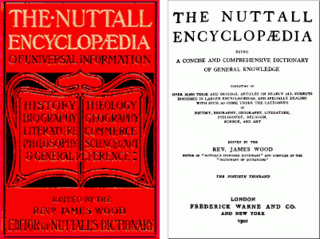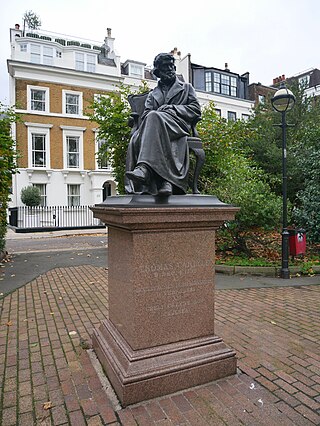
The Divine Comedy is an Italian narrative poem by Dante Alighieri, begun c. 1308 and completed around 1321, shortly before the author's death. It is widely considered the pre-eminent work in Italian literature and one of the greatest works of world literature. The poem's imaginative vision of the afterlife is representative of the medieval worldview as it existed in the Western Church by the 14th century. It helped establish the Tuscan language, in which it is written, as the standardized Italian language. It is divided into three parts: Inferno, Purgatorio, and Paradiso.

In Greek mythology, Phlegyas was a king of the Lapiths.

Thomas Carlyle was a British essayist, historian, and philosopher from the Scottish Lowlands. A leading writer of the Victorian era, he exerted a profound influence on 19th-century art, literature, and philosophy.
Ecclefechan is a small village located in Dumfries and Galloway in the south of Scotland.

Sir Joseph Edgar Boehm, 1st Baronet, was an Austrian-born British medallist and sculptor, best known for the "Jubilee head" of Queen Victoria on coinage, and the statue of the Duke of Wellington at Hyde Park Corner. During his career Boehm maintained a large studio in London and produced a significant volume of public works and private commissions. A speciality of Boehm's was the portrait bust; there are many examples of these in the National Portrait Gallery. He was often commissioned by the Royal Family and members of the aristocracy to make sculptures for their parks and gardens. His works were many, and he exhibited 123 of them at the Royal Academy from 1862 to his death in 1890.

Church Knowle is a village and civil parish on the Isle of Purbeck in the county of Dorset in the south of England.

Carlyle's House, in Cheyne Row, Chelsea, central London, was the home of the Scottish essayist, historian and philosopher Thomas Carlyle and his wife Jane from 1834 until his death. The home of these writers was purchased by public subscription and placed in the care of the Carlyle's House Memorial Trust in 1895. They opened the house to the public and maintained it until 1936, when control of the property was assumed by the National Trust, inspired by co-founder Octavia Hill's earlier pledge of support for the house. It became a Grade II listed building in 1954 and is open to the public as a historic house museum.

Annan is a town and former royal burgh in Dumfries and Galloway, south-west Scotland. Historically part of Dumfriesshire, its public buildings include Annan Academy, of which the writer Thomas Carlyle was a pupil, and a Georgian building now known as "Bridge House". Annan also features a Historic Resources Centre. In Port Street, some of the windows remain blocked up to avoid paying the window tax.

Craigenputtock is an estate in Scotland where Thomas Carlyle lived from 1828 to 1834. He wrote several of his early works there, including Sartor Resartus.

James Wood was a Scottish writer, editor, and Free Church minister.
Events from the year 1881 in the United Kingdom.
Events from the year 1873 in Scotland.

Thomas Stuart Burnett ARSA was a Scottish sculptor in the 19th century.

Robert Lorimer was a Presbyterian minister who served in Haddington. After nearly 50 years in the Church of Scotland ministry he walked out during the schism known as The Disruption and joined the Free Church of Scotland.

A statue of Thomas Carlyle by Joseph Edgar Boehm stands in Chelsea Embankment Gardens in London. Erected in 1881 and unveiled in 1882, it stands close to 24 Cheyne Row where Carlyle lived for the last 47 years of his life. The statue became a Grade II listed building on 15 April 1969.

Thomas Carlyle is an unfinished portrait of the Scottish essayist, historian and philosopher of the same name painted by English Pre-Raphaelite painter John Everett Millais in 1877.

Scotsbrig is a farm near Ecclefechan, Dumfries and Galloway, Scotland, and a Category B listed building. Thomas Carlyle lived there with his family in the summer of 1826 before moving to 21 Comely Bank, Edinburgh. Scotsbrig remained a residence of the Carlyle family for decades. The farmhouse underwent numerous additions and renovations in the eighteenth and nineteenth centuries.

George Lawson D.D. (1749–1820) was a Scottish minister of the Secession Church, known as a biblical scholar. Thomas Carlyle, in an 1870 letter to Lawson's biographer John Macfarlane, called him "a most superlative steel-grey Scottish peasant ".

















